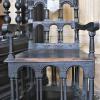Collections in the Upper Gallery
Commentary
Since the mid-nineteenth century, the third floor which Thomas Bodley added to the Schools Quadrangle has been used as a reading room. But for two centuries after its construction, it was known as a ‘gallery’, intended for ‘edifying perambulation’ like the long gallery of a contemporary great house. As late as 1829 it displayed painting, sculture, and other material from the University's collections not suitable for the Ashmolean (which was still housed in its original building, which today hosts the History of Science Museum). It was the building of the current Ashmolean Museum in 1845 which allowed all of these collections eventually to be transferred to the Ashmolean, and the gallery refitted as the Upper Reading Room more or less as we know it today.
A decade after its construction, its contents were described in 1629 by a Dutch visitor, Abram Booth, as follows.
One goes up via two staircases to a wonderfully spacious Gallery decorated with pictures of all scholars renowned to this day; furthermore, from here one enters a specially designed room of antiquities in which very old medals and many other curiosities are kept.
The painted frieze which ran around the Gallery just below the ceiling (painted in 1619, plastered over in 1830, and rediscovered in 1949) included portraits of 202 celebrated authors from all ages, selected it seems by Bodley himself perhaps in partnership with his first librarian, Thomas James. Together, they give a wonderfully clear picture of the theological ideas and learned values of the founder, and as such they deserve more attention here in the future.*
The centrepiece in this engraving is provided by the bronze statue of William Herbert, 3rd Earl of Pembroke (1580–1630), chancellor of the University from 1617 until his death, founder of Pembroke College in 1624, and a major benefactor of the Bodleian. Based on sketch by Rubens, it was cast around 1630 by Henry Le Sueur, a French sculptor attracted to England by Charles I. It was only moved to the Bodleian in 1723 and was originally displayed in the gallery. Photographs from the 1890s and and 1929 shows it still in this position, even after the gallery was transformed into the Upper Reading Room. It now stands outside in the Schools Qudrangle, immediately in front of the main entrance to the Proscholium.
An impression of the rather miscellaneous collections on display can be gathered from the description penned by the Frankfurt patrician, Zacharias Conrad von Uffenbach, after a visit to Oxford in 1710.**
We were also shown a large volume with all sorts of collected engravings, amongst which were several by good artists. After this a great armchair was pointed out to us, as something very special, because it is said to have been made out of the ship in which Captain Drake sailed round the world ; also several Chinese staves, bow and arrows, and again a cylinder with some vile figures. The most remarkable thing was the marble, of which Monconys speaks in his travels. It is set in a frame and hangs on the wall. The lizard or squirrel formed in it is very strange and is a white vein natural to the marble which represents this animal very prettily….
There is close by another cabinet, in which formerly Laudi Numismata [Laud’s coin collection] were kept… but the coins have been moved into the first one and unbound books put in their place…. The cabinet itself is very large and comparatively well-wrought – but old French in style like the old trésors. At the top are some large drawers, out of which Mr. Crab, with much circumstance and as if it were a sacred thing, reached down an old sword with a hilt of silver-gilt. This is said to be the one sent by Pope Leo X. to Henry VIII as Defender of the Faith. It has a large knob of crystal, which can be unscrewed and in which is painted a golden hour-glass with the word: Vigilate. Mr Crab also showed us something very curious: a gilt chain with a portrait given by the Emperor to a poet who had been crowned with laurels.
The sword given by Pope Leo X to Henry VIII is now in the Ashmolean. The Drake Chair is currently in the Divinity School.
References
* Quotation from, and more information available in, Margaret Bullard, ‘Talking Heads: The Bodleian Frieze, its Inspiration, Sources, Designers, and Significance’, Bodleian Library Record, vol. 14 [1994], pg. 461-500, who quotes Booth on 466. The Wikipedia article lists the portraits.
** W. H. Quarrell and W. J. C. Quarrell, ed. and trans., Oxford in 1710: From the Travels of Zacharias Conrad von Uffenbach (Oxford, 1928), 13-14.
Credits: Howard Hotson, March 2021

